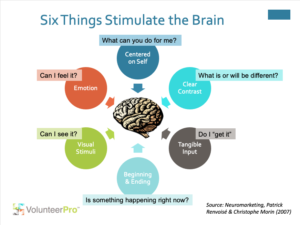
How to Recruit Volunteers by Speaking to the “Old Brain”
For years now, I’ve been fascinated with how to recruit volunteers by harnessing how we humans actually function. In other words, how we are motivated to make decisions and are persuaded to act.
I call it “working with human nature, not against it.”
And it makes sense. It is a fool’s errand to try to buck thousands of years of human evolution.
Our brains are hardwired to behave in certain ways. It’s what’s kept us alive as a species for so long.
And if you know anything about the pace of biological evolution, it takes forever for change to happen. Cultural evolution may take a little less time, but it’s still a slow go.
So, why not work with the brain, instead of against it?
Several years ago, I read the book Neuromarketing: Understanding the Buy Buttons in Your Customer’s Brain by Patrick Renvoisé and Christophe Morin. It was early in the understanding of brain science when the technology to actually measure changes in the human brain in real time was surging.
The book offered an engrossing look at how human beings are hard-wired to behave in specific ways, based on certain triggers. The book wasn’t only for business executives or corporate marketing firms. It included smart information for how to influence others.
I wondered how these new discoveries could be used for good. And I began to consider how these new insights could be used to strengthen our efforts to recruit volunteers for nonprofits and engage communities in supporting the greater good.
In the book, Renvoisé and Morin explained that our brains have developed over thousands of years of human evolution and have a concrete role in helping us survive as a species.
They noted that our behavior is often pre-programmed, partly because our grey matter simply cannot process all of the information coming at us each day. So, we react in stereotypical ways based on cues that tell us, in shorthand, what is going on in front of us.
Some scientists argue that because human brains are being bombarded more and more with information, this will continue to be the case, but in an even more pronounced way.
So, learning how to work with our innate systems will become even more important in order to be heard above the din.
So, rather than guess what will appeal to potential volunteers, why not harness human nature and get it to work for you?
On a practical level, Renvoisé and Morin explained that when persuading our fellow humans to make a decision to change behavior, we must speak to the “primitive” (or “old”) brain.
Contrary to past theories that painted humans as rational, methodical decision-makers, scientists have learned that it is the emotional part of our brains that actually processes information. This emotional side then tells our rational side whether or not to act.
In other words, the heart decides, the intellect justifies.
The kicker is that this is all going on a subconscious level.
The authors identified six triggers that wake up the primitive brain and get it to consider a decision. And they argued that in order to persuade someone to act, you must tap at least one.
You’ll find them below, with my thoughts on how to use them in your volunteer recruitment appeals.
For more on how to become a volunteer magnet, check out our post 5 Key Factors in Creating a Program That Will Attract Volunteers
How to Recruit Volunteers with Appeals that Tap What Really Motivates Us
The way we messaging to potential volunteers can have immense impact on whether or not they decided to act. Copywriting does matter.
Our appeals need to be brain-friendly in order to capture attention in today’s distracted marketplace and slow the brain down. Then, and only then, can messages been forwarded to the more rational side of our consciousness and elevate to the level of a potential decision.

Below are three ways to grab the attention of the “old” brain long enough to make the case for service.
Consider how many of these elements you currently employ in your volunteer recruitment outreach and marketing. Then, consider what adjustment you might make to convert forgettable creative and copywriting into something that actually work with our innate functions.
If you don’t trust yourself, try this: Show a before and after of one of your volunteer recruitment appeals to a group of your current volunteers. Ask them which they like better.
The brain-based appeal will nearly always win.
For more on how to develop a full volunteer recruitment messaging strategy, check out our post How to Write Volunteer Recruitment Messaging That Converts
Capturing the Attention of the “Old Brain”
- Centered on Self – The old brain is completely self-centered. Appeals that use the word “you” will be more effective. Also, answering the question “What can you do for me?” clearly and succinctly will help get attention.
-
- Implementation Idea: Create a quiz that you post on your volunteer recruitment page – What kind of volunteer are you? Then, offer suggestions for roles based on the volunteer’s results.
- Implementation Idea: Create a quiz that you post on your volunteer recruitment page – What kind of volunteer are you? Then, offer suggestions for roles based on the volunteer’s results.
- Clear Contrast – The old brain is sensitive to clear contrasts; in fact, it is always scanning our surroundings for disruptions to the norm. Create contrast to get attention by focusing on the reality of their involvement before or after, or by clearly communicating what makes your program unique by comparing your opportunity versus others that are available.
-
- Implementation Idea: Show before and after photos of the difference volunteers make in your social media. For example, empty table versus table full of delicious meals with people at it or empty baseball diamond versus field full of happy kids running around.
- Implementation Idea: Show before and after photos of the difference volunteers make in your social media. For example, empty table versus table full of delicious meals with people at it or empty baseball diamond versus field full of happy kids running around.
- Tangible Input – The old brain processes information very quickly, and if waylaid, will forward the info to the new brain which slows decision-making to a screeching halt. Communicate simple, concrete ideas and do away with any acronyms or jargon that will slow the brain processing.
-
- Implementation Idea: Boil your volunteer application process down to 3-5 simple steps and promote “how to volunteer in 3 easy steps” on your volunteer application page. This is sometimes hard to do for organizations that have complex onboarding processes, but if you work at it, you can find a simpler way to explain what volunteers must do to join.
- Implementation Idea: Boil your volunteer application process down to 3-5 simple steps and promote “how to volunteer in 3 easy steps” on your volunteer application page. This is sometimes hard to do for organizations that have complex onboarding processes, but if you work at it, you can find a simpler way to explain what volunteers must do to join.
- Beginning & Ending – The old brain conserves energy by focusing on beginnings and endings. Create a sense of anticipation (which also increases dopamine production and helps people remember) by previewing the intrinsic rewards the volunteer will gain from the experience and then by repeating them at the end of the appeal.
-
- Implementation Idea: Pay a LOT of attention to creating an exceptional first impression for new volunteers. Day 1 of a volunteer shift really does set the stage for future engagement and your organization’s ability to retain quality talent. So, don’t leave it up to chance or grumpy staffers.
- Implementation Idea: Pay a LOT of attention to creating an exceptional first impression for new volunteers. Day 1 of a volunteer shift really does set the stage for future engagement and your organization’s ability to retain quality talent. So, don’t leave it up to chance or grumpy staffers.
- Visual Stimuli – The optic nerve is forty times faster than the auditory nerve, and so it feeds info to the old brain much faster. Because of this, humans are hardwired to make decisions largely based on visual input. So, use photos and video liberally to tell your story.
-
- Implementation Idea: Choose photos that include close-ups of smiling faces, not big teams from far away. It’s more about the feelings the photo shares than the actual details it shows. Evaluate all photos you choose to share in your marketing on an emotional level.
- Implementation Idea: Choose photos that include close-ups of smiling faces, not big teams from far away. It’s more about the feelings the photo shares than the actual details it shows. Evaluate all photos you choose to share in your marketing on an emotional level.
- Emotion – The old brain is triggered by emotions. We remember events better when they are accompanied by strong feelings. So, make use of powerful stories of human transformation and change a central part of your communications.
-
- Implementation Idea: Forget all of the details about the “do’s and don’ts” of volunteering. Rather when recruiting new volunteers, lead with stories about change – change in customers or clients, change in volunteers, change in staff. Humans love to read about triumph over adversity, no matter how small.
For more on how to design a successful call to action, check out our post Recruitment Messaging: Crafting Your Most Successful Call for Volunteers Yet!

More on Building Better Brain-friendly Stories
From a purely objective, non-value judgment basis, it appears that we humans make decisions in ways that are focused on our self-interests. In addition, we are intensely curious about what’s happening with others around us (social media, anyone?).
Since that’s the case, part of a brain-based volunteer recruitment strategy should also include plenty of storytelling.
Use these questions to better understand the language and “voice” of volunteers and to generate specific quotes you can use in your calls to action.
You can collect stories to share through volunteer surveys, individual interviews, and small focus groups or listening sessions.
When collecting stories, focus on investigating the emotional aspect of the experience. Ask volunteers to elucidate on their feelings, not just the fact. This will generate better stories, that will delight those who encounter them because they will appeal to their innate biology.
Below are some questions to get you started.
Volunteer Survey, Interview, or Focus Group Questions
- Who are you? How would you describe your connection to this cause?
- What motivated you to volunteer? What problem does it solve for you?
- How is your life better because of volunteering? Which tangible improvements in your life have you seen?
- What changes or developments have you seen in others?
- What do you like about volunteering with us the most?
- Tell me about a pivotal moment in your experience. How did that make you feel?
- Did you consider any other places to volunteer? If so, which ones? Why did you choose us over others?
- What made you ultimately sign up? What convinced you that it was a good decision?
- Which doubts and hesitations did you have before joining? Can you tell me more about that?
- Which questions did you have, but couldn’t find answers to?
- Anything else you would like to tell us?
- What would you tell others who might be exploring whether they will join our team? What should they know?
- Others specific to your cause (e.g., misperceptions about your mission or work, reservations about specific volunteer application or training requirements, etc.)
Everyone has a compelling story to tell. When asking questions of volunteers, follow up their initial answers with a simple. “Tell me more.” You’ll soon get into the interesting part of their experience.
![]()

![]()
In the end, convincing people to donate their time and energy to your good cause often feels like an uphill battle.
But it needn’t be.
Smart volunteer recruiters tap what science tells us – in the fields of psychology, behavioral economics, and neuromarketing – about what motivates human behavior.
Believe it or not, we humans are pretty predictable …if not always rational!
Take time to craft creative recruitment messages that inspire authentic heart-to-heart connections and move people to action by working with human nature, not against it, and you’ll soon become the volunteer magnet you were meant to be.
Level Up Your Volunteer Engagement with Our Free Guide
Are you a nonprofit or public sector organization looking for inspirational guidance on how to lead volunteers with purpose? Then, look no further.
Our VolunteerPro Essential Guide to Managing Volunteers in Your Nonprofit will help you get started off on the right foot. Whether you are brand new to volunteer coordination or have been at for years, we hope you’ll find some helpful advice and resources on these pages.
Managing volunteers needn’t be a source of frustration. With a little investment of time and attention, your nonprofit can generate powerful volunteer impact that expands your base of donors and supporters and strengthens connections with diverse communities far beyond your agency’s doors.








Leave A Comment